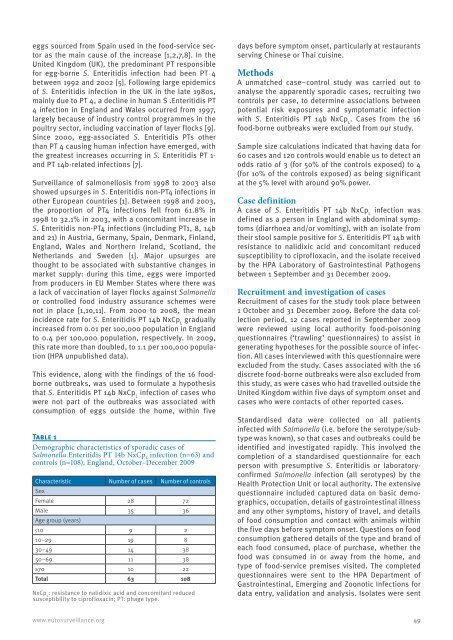Escherichia coli - Eurosurveillance
Escherichia coli - Eurosurveillance
Escherichia coli - Eurosurveillance
Create successful ePaper yourself
Turn your PDF publications into a flip-book with our unique Google optimized e-Paper software.
eggs sourced from Spain used in the food-service sector<br />
as the main cause of the increase [1,2,7,8]. In the<br />
United Kingdom (UK), the predominant PT responsible<br />
for egg-borne S. Enteritidis infection had been PT 4<br />
between 1992 and 2002 [5]. Following large epidemics<br />
of S. Enteritidis infection in the UK in the late 1980s,<br />
mainly due to PT 4, a decline in human S .Enteritidis PT<br />
4 infection in England and Wales occurred from 1997,<br />
largely because of industry control programmes in the<br />
poultry sector, including vaccination of layer flocks [9].<br />
Since 2000, egg-associated S. Enteritidis PTs other<br />
than PT 4 causing human infection have emerged, with<br />
the greatest increases occurring in S. Enteritidis PT 1-<br />
and PT 14b-related infections [7].<br />
Surveillance of salmonellosis from 1998 to 2003 also<br />
showed upsurges in S. Enteritidis non-PT4 infections in<br />
other European countries [1]. Between 1998 and 2003,<br />
the proportion of PT4 infections fell from 61.8% in<br />
1998 to 32.1% in 2003, with a concomitant increase in<br />
S. Enteritidis non-PT4 infections (including PT1, 8, 14b<br />
and 21) in Austria, Germany, Spain, Denmark, Finland,<br />
England, Wales and Northern Ireland, Scotland, the<br />
Netherlands and Sweden [1]. Major upsurges are<br />
thought to be associated with substantive changes in<br />
market supply: during this time, eggs were imported<br />
from producers in EU Member States where there was<br />
a lack of vaccination of layer flocks against Salmonella<br />
or controlled food industry assurance schemes were<br />
not in place [1,10,11]. From 2000 to 2008, the mean<br />
incidence rate for S. Enteritidis PT 14b NxCp L gradually<br />
increased from 0.01 per 100,000 population in England<br />
to 0.4 per 100,000 population, respectively. In 2009,<br />
this rate more than doubled, to 1.1 per 100,000 population<br />
(HPA unpublished data).<br />
This evidence, along with the findings of the 16 foodborne<br />
outbreaks, was used to formulate a hypothesis<br />
that S. Enteritidis PT 14b NxCp L infection of cases who<br />
were not part of the outbreaks was associated with<br />
consumption of eggs outside the home, within five<br />
Table 1<br />
Demographic characteristics of sporadic cases of<br />
Salmonella Enteritidis PT 14b NxCp L infection (n=63) and<br />
controls (n=108), England, October–December 2009<br />
Characteristic<br />
Sex<br />
Number of cases Number of controls<br />
Female 28 72<br />
Male<br />
Age group (years)<br />
35 36<br />

















